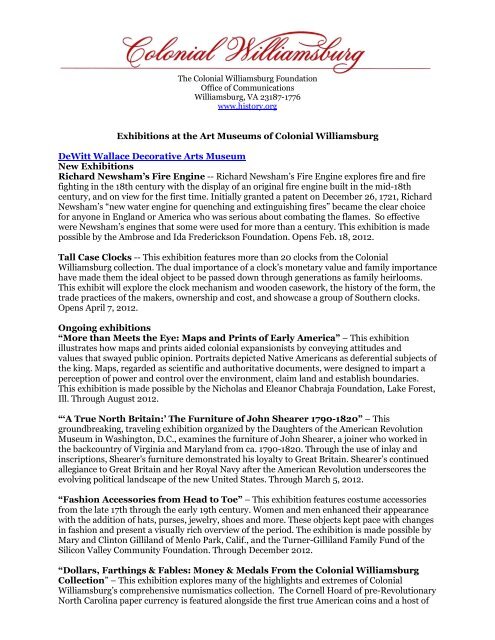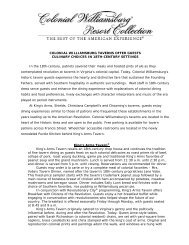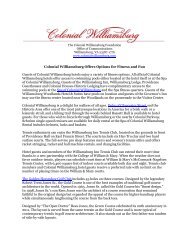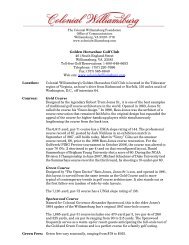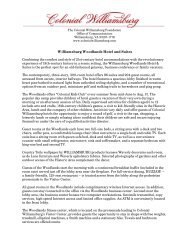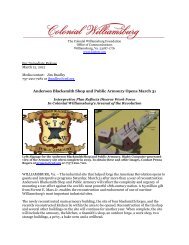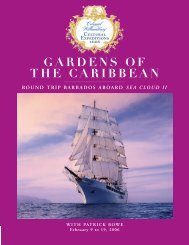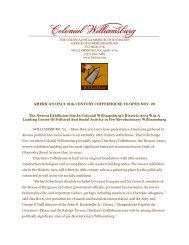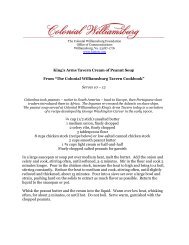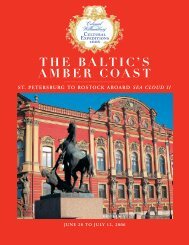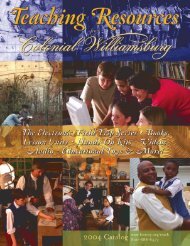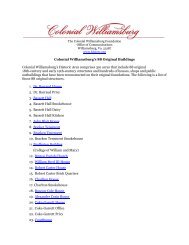Exhibitions at the Art Museums of Colonial Williamsburg DeWitt ...
Exhibitions at the Art Museums of Colonial Williamsburg DeWitt ...
Exhibitions at the Art Museums of Colonial Williamsburg DeWitt ...
Create successful ePaper yourself
Turn your PDF publications into a flip-book with our unique Google optimized e-Paper software.
The <strong>Colonial</strong> <strong>Williamsburg</strong> Found<strong>at</strong>ion<br />
Office <strong>of</strong> Communic<strong>at</strong>ions<br />
<strong>Williamsburg</strong>, VA 23187-1776<br />
www.history.org<br />
<strong>Exhibitions</strong> <strong>at</strong> <strong>the</strong> <strong>Art</strong> <strong>Museums</strong> <strong>of</strong> <strong>Colonial</strong> <strong>Williamsburg</strong><br />
<strong>DeWitt</strong> Wallace Decor<strong>at</strong>ive <strong>Art</strong>s Museum<br />
New <strong>Exhibitions</strong><br />
Richard Newsham’s Fire Engine -- Richard Newsham’s Fire Engine explores fire and fire<br />
fighting in <strong>the</strong> 18th century with <strong>the</strong> display <strong>of</strong> an original fire engine built in <strong>the</strong> mid-18th<br />
century, and on view for <strong>the</strong> first time. Initially granted a p<strong>at</strong>ent on December 26, 1721, Richard<br />
Newsham’s “new w<strong>at</strong>er engine for quenching and extinguishing fires” became <strong>the</strong> clear choice<br />
for anyone in England or America who was serious about comb<strong>at</strong>ing <strong>the</strong> flames. So effective<br />
were Newsham’s engines th<strong>at</strong> some were used for more than a century. This exhibition is made<br />
possible by <strong>the</strong> Ambrose and Ida Frederickson Found<strong>at</strong>ion. Opens Feb. 18, 2012.<br />
Tall Case Clocks -- This exhibition fe<strong>at</strong>ures more than 20 clocks from <strong>the</strong> <strong>Colonial</strong><br />
<strong>Williamsburg</strong> collection. The dual importance <strong>of</strong> a clock’s monetary value and family importance<br />
have made <strong>the</strong>m <strong>the</strong> ideal object to be passed down through gener<strong>at</strong>ions as family heirlooms.<br />
This exhibit will explore <strong>the</strong> clock mechanism and wooden casework, <strong>the</strong> history <strong>of</strong> <strong>the</strong> form, <strong>the</strong><br />
trade practices <strong>of</strong> <strong>the</strong> makers, ownership and cost, and showcase a group <strong>of</strong> Sou<strong>the</strong>rn clocks.<br />
Opens April 7, 2012.<br />
Ongoing exhibitions<br />
“More than Meets <strong>the</strong> Eye: Maps and Prints <strong>of</strong> Early America” – This exhibition<br />
illustr<strong>at</strong>es how maps and prints aided colonial expansionists by conveying <strong>at</strong>titudes and<br />
values th<strong>at</strong> swayed public opinion. Portraits depicted N<strong>at</strong>ive Americans as deferential subjects <strong>of</strong><br />
<strong>the</strong> king. Maps, regarded as scientific and authorit<strong>at</strong>ive documents, were designed to impart a<br />
perception <strong>of</strong> power and control over <strong>the</strong> environment, claim land and establish boundaries.<br />
This exhibition is made possible by <strong>the</strong> Nicholas and Eleanor Chabraja Found<strong>at</strong>ion, Lake Forest,<br />
Ill. Through August 2012.<br />
“‘A True North Britain:’ The Furniture <strong>of</strong> John Shearer 1790-1820” – This<br />
groundbreaking, traveling exhibition organized by <strong>the</strong> Daughters <strong>of</strong> <strong>the</strong> American Revolution<br />
Museum in Washington, D.C., examines <strong>the</strong> furniture <strong>of</strong> John Shearer, a joiner who worked in<br />
<strong>the</strong> backcountry <strong>of</strong> Virginia and Maryland from ca. 1790-1820. Through <strong>the</strong> use <strong>of</strong> inlay and<br />
inscriptions, Shearer’s furniture demonstr<strong>at</strong>ed his loyalty to Gre<strong>at</strong> Britain. Shearer’s continued<br />
allegiance to Gre<strong>at</strong> Britain and her Royal Navy after <strong>the</strong> American Revolution underscores <strong>the</strong><br />
evolving political landscape <strong>of</strong> <strong>the</strong> new United St<strong>at</strong>es. Through March 5, 2012.<br />
“Fashion Accessories from Head to Toe” – This exhibition fe<strong>at</strong>ures costume accessories<br />
from <strong>the</strong> l<strong>at</strong>e 17th through <strong>the</strong> early 19th century. Women and men enhanced <strong>the</strong>ir appearance<br />
with <strong>the</strong> addition <strong>of</strong> h<strong>at</strong>s, purses, jewelry, shoes and more. These objects kept pace with changes<br />
in fashion and present a visually rich overview <strong>of</strong> <strong>the</strong> period. The exhibition is made possible by<br />
Mary and Clinton Gilliland <strong>of</strong> Menlo Park, Calif., and <strong>the</strong> Turner-Gilliland Family Fund <strong>of</strong> <strong>the</strong><br />
Silicon Valley Community Found<strong>at</strong>ion. Through December 2012.<br />
“Dollars, Farthings & Fables: Money & Medals From <strong>the</strong> <strong>Colonial</strong> <strong>Williamsburg</strong><br />
Collection” – This exhibition explores many <strong>of</strong> <strong>the</strong> highlights and extremes <strong>of</strong> <strong>Colonial</strong><br />
<strong>Williamsburg</strong>’s comprehensive numism<strong>at</strong>ics collection. The Cornell Hoard <strong>of</strong> pre-Revolutionary<br />
North Carolina paper currency is fe<strong>at</strong>ured alongside <strong>the</strong> first true American coins and a host <strong>of</strong>
<strong>Exhibitions</strong> <strong>at</strong> <strong>the</strong> <strong>Art</strong> <strong>Museums</strong> <strong>of</strong> <strong>Colonial</strong> <strong>Williamsburg</strong> – Page 2<br />
o<strong>the</strong>r types <strong>of</strong> money and medals with fascin<strong>at</strong>ing stories to tell. This exhibition includes many<br />
objects don<strong>at</strong>ed by <strong>the</strong> Joseph R. Lasser Family <strong>of</strong> New York.<br />
“Rebuilding Charlton’s C<strong>of</strong>feehouse” - This exhibition explores <strong>the</strong> recent reconstruction<br />
<strong>of</strong> R. Charlton’s C<strong>of</strong>feehouse, <strong>the</strong> first ground-up reconstruction along Duke <strong>of</strong> Gloucester Street<br />
in several decades which involved every department and trade in <strong>the</strong> Found<strong>at</strong>ion. Visitors<br />
discover how such a building could be so accur<strong>at</strong>ely constructed and furnished when seemingly<br />
very little was left <strong>of</strong> <strong>the</strong> original structure. Through archaeological, architectural, archival,<br />
decor<strong>at</strong>ive arts and trades components, guests discover <strong>the</strong> process <strong>of</strong> rebuilding <strong>the</strong> history,<br />
structure and interiors <strong>of</strong> <strong>the</strong> c<strong>of</strong>feehouse. Visitors learn firsthand wh<strong>at</strong> it took to bring <strong>the</strong><br />
project to completion through video, graphics, original objects and touchable reproductions. The<br />
reconstruction <strong>of</strong> R. Charlton’s C<strong>of</strong>feehouse was made possible with a generous gift from Forrest<br />
Mars.<br />
“Conserv<strong>at</strong>ion: Where <strong>Art</strong> and Science Meet” - This exhibition presents <strong>the</strong> way museum<br />
objects are conserved before <strong>the</strong>y are exhibited. Visitors will discover <strong>the</strong> variety <strong>of</strong> techniques<br />
used by conserv<strong>at</strong>ors to investig<strong>at</strong>e each object and ensure its preserv<strong>at</strong>ion for <strong>the</strong> future. This<br />
exhibition was made possible in part by Friends <strong>of</strong> Heritage Preserv<strong>at</strong>ion and <strong>the</strong> Stone Family<br />
Fund. Through August 2012.<br />
“Introduction to <strong>the</strong> <strong>Museums</strong>” – This exhibition orients visitors to <strong>the</strong> <strong>DeWitt</strong> Wallace<br />
Decor<strong>at</strong>ive <strong>Art</strong>s Museum, <strong>the</strong> Abby Aldrich Rockefeller Folk <strong>Art</strong> Museum and <strong>the</strong> many tours,<br />
family programs and auditorium productions to be found in <strong>the</strong> <strong>Art</strong> <strong>Museums</strong> <strong>of</strong> <strong>Colonial</strong><br />
<strong>Williamsburg</strong>.<br />
“Treasure Quests: Gre<strong>at</strong> Silver Collections from <strong>Colonial</strong> <strong>Williamsburg</strong>” - This<br />
exhibition in <strong>the</strong> Mary Jewett Gaiser Gallery displays selections from <strong>the</strong> Found<strong>at</strong>ion’s vast<br />
collection <strong>of</strong> 18th-century British silver.<br />
“Identifying Ceramics: The Who, Wh<strong>at</strong> and Ware” - This exhibition takes a closer look<br />
<strong>at</strong> <strong>the</strong> production and decor<strong>at</strong>ion <strong>of</strong> ceramic wares <strong>of</strong> <strong>the</strong> 18th century. Find out <strong>the</strong> difference<br />
between stoneware, ear<strong>the</strong>nware and porcelain and discover how ornament was cre<strong>at</strong>ed or<br />
applied.<br />
“Masterworks from <strong>the</strong> <strong>Colonial</strong> <strong>Williamsburg</strong> Collection” – The selected objects are<br />
arranged in chronological order and have been chosen for <strong>the</strong>ir artistic merit, <strong>the</strong>ir historical<br />
significance and <strong>the</strong>ir excellent st<strong>at</strong>e <strong>of</strong> preserv<strong>at</strong>ion.<br />
“Selections from <strong>the</strong> Henry H. Weldon Collection” – This exhibit fe<strong>at</strong>ures a few select<br />
pieces from <strong>the</strong> collection <strong>of</strong> more than 725 pieces <strong>of</strong> 18th-century British pottery don<strong>at</strong>ed to<br />
<strong>Colonial</strong> <strong>Williamsburg</strong> by Mr. and Mrs. Henry H. Weldon.<br />
“Lock, Stock & Barrel: Early Firearms from <strong>the</strong> <strong>Colonial</strong> <strong>Williamsburg</strong> Collection”<br />
– This exhibition showcases military and civilian firearms, including muzzle-loading, ignition<br />
systems and <strong>the</strong> evolution <strong>of</strong> <strong>the</strong> standard British infantry musket pre-1800.<br />
“Revolution in Taste” – The exhibition covers <strong>the</strong> variety <strong>of</strong> wares manufactured in <strong>the</strong><br />
period th<strong>at</strong> <strong>of</strong>fered colonists a wide range <strong>of</strong> goods associ<strong>at</strong>ed with dining, drinking and<br />
decor<strong>at</strong>ion.<br />
The Abby Aldrich Rockefeller Folk <strong>Art</strong> Museum<br />
New exhibition<br />
Quilts in <strong>the</strong> Baltimore Manner -- The quilts <strong>of</strong> Baltimore, Maryland, are noted for <strong>the</strong>ir<br />
strong design, excellent craftsmanship, and brilliant colors. The designs <strong>of</strong> Baltimore influenced<br />
<strong>the</strong> wider community <strong>of</strong> quilters, including areas beyond Baltimore, such as Nor<strong>the</strong>rn Virginia.
<strong>Exhibitions</strong> <strong>at</strong> <strong>the</strong> <strong>Art</strong> <strong>Museums</strong> <strong>of</strong> <strong>Colonial</strong> <strong>Williamsburg</strong> – Page 3<br />
This exhibit fe<strong>at</strong>ures 12 quilts from Baltimore and surrounding areas, d<strong>at</strong>ing from <strong>the</strong> 1820s<br />
through <strong>the</strong> 1860s. Opens May 2012.<br />
Ongoing exhibitions<br />
“The Old Plant<strong>at</strong>ion: The <strong>Art</strong>ist Revealed” – This exhibition explores <strong>the</strong> clues th<strong>at</strong> led to<br />
finally identifying <strong>the</strong> artist who cre<strong>at</strong>ed this 18th-century w<strong>at</strong>ercolor. This important piece<br />
depicting slave life has been in <strong>the</strong> collection for more than 70 years but little was known <strong>of</strong> its<br />
cre<strong>at</strong>or or <strong>the</strong> subjects. Now <strong>the</strong> mystery is solved and <strong>the</strong> exhibition reveals <strong>the</strong> history <strong>of</strong> <strong>the</strong><br />
drawing and <strong>the</strong> identity <strong>of</strong> <strong>the</strong> artist.<br />
“<strong>Art</strong> in Clay: Masterworks <strong>of</strong> North Carolina Ear<strong>the</strong>nware” – This loaned exhibition<br />
showcases one <strong>of</strong> <strong>the</strong> most important and aes<strong>the</strong>tically significant American pottery traditions.<br />
It fe<strong>at</strong>ures dazzling slip-decor<strong>at</strong>ed wares and richly glazed sculptural bottles made between 1755<br />
and 1850. The exhibition was sponsored by Old Salem <strong>Museums</strong> & Gardens, <strong>the</strong> Chipstone<br />
Found<strong>at</strong>ion and <strong>the</strong> Caxambas Found<strong>at</strong>ion. Through July 29, 2012, in <strong>the</strong> Gladys & Franklin<br />
Clark Found<strong>at</strong>ion Gallery.<br />
“M<strong>at</strong>erial Witnesses: Quilts and <strong>the</strong>ir Makers” – This exhibition fe<strong>at</strong>ures 12 quilts and<br />
three woven coverlets. Each piece reveals <strong>the</strong> story <strong>of</strong> <strong>the</strong> person who made it, whe<strong>the</strong>r it was a<br />
young woman or a pr<strong>of</strong>essional weaver or a group <strong>of</strong> friends. All stand as evidence <strong>of</strong> <strong>the</strong> lives <strong>of</strong><br />
people from <strong>the</strong> past. This exhibition was made possible by Mary and Clinton Gilliland <strong>of</strong> Menlo<br />
Park, Calif., through <strong>the</strong> Turner-Gilliland Family Fund. Through April 2012.<br />
“Sidewalks to Ro<strong>of</strong>tops: Outdoor Folk <strong>Art</strong>” – This exhibition presents signboards,<br />
storefront figures, we<strong>at</strong>her vanes, marine carvings, whirligigs, carousel animals and o<strong>the</strong>r<br />
objects originally intended for use outdoors. This exhibition was made possible by a gift from<br />
Barry M. Boone in loving memory <strong>of</strong> his wife, Linda. Through January 2013.<br />
“An Introduction to American Folk <strong>Art</strong>” – Guests are introduced to <strong>the</strong> museum and to<br />
<strong>the</strong> collector Abby Aldrich Rockefeller.<br />
“Conserving <strong>the</strong> Carolina Room” – This exhibition highlights <strong>the</strong> current research and<br />
conserv<strong>at</strong>ion on a 19th-century painted room acquired by <strong>the</strong> museum in <strong>the</strong> 1950s. The<br />
conserv<strong>at</strong>ion <strong>of</strong> <strong>the</strong> Carolina Room has been partially underwritten by Rex and P<strong>at</strong> Lucke <strong>of</strong><br />
Elkhorn, Neb., and <strong>the</strong> N<strong>at</strong>ional Endowment for <strong>the</strong> <strong>Art</strong>s. The room is on display in <strong>the</strong> Rex and<br />
P<strong>at</strong> Lucke Gallery.<br />
“Inspir<strong>at</strong>ion and Ingenuity: American Stoneware” – “American Stoneware” fe<strong>at</strong>ures<br />
stoneware pieces from <strong>the</strong> 19th century through <strong>the</strong> present day. The exhibition explores <strong>the</strong><br />
tradition <strong>of</strong> decor<strong>at</strong>ing utilitarian stoneware and its evolution into an art form.<br />
“Down on <strong>the</strong> Farm” – This family-friendly exhibition fe<strong>at</strong>ures animals in paintings,<br />
sculpture and toys.<br />
“Cross Rhythms: Folk Musical Instruments” – This exhibition fe<strong>at</strong>ures banjos, fiddles<br />
and dulcimers from <strong>the</strong> 19th century and early 20th century. Highlights include a piano built<br />
into a chest <strong>of</strong> drawers and a record-playing hippocerous.<br />
For more inform<strong>at</strong>ion, visit us <strong>at</strong> our website <strong>at</strong> www.history.org.
<strong>Exhibitions</strong> <strong>at</strong> <strong>the</strong> <strong>Art</strong> <strong>Museums</strong> <strong>of</strong> <strong>Colonial</strong> <strong>Williamsburg</strong> – Page 4<br />
Media contact:<br />
Jim Bradley<br />
(757) 220-7281<br />
01/12


